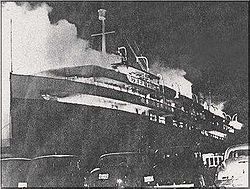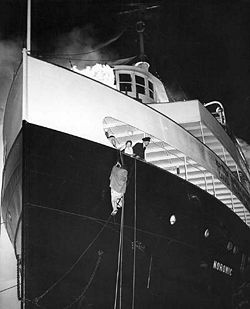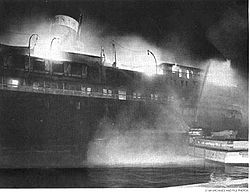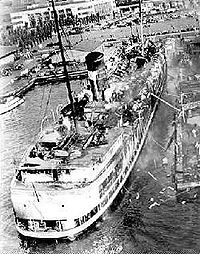SS Noronic
The SS Noronic was a passenger ship that was destroyed by fire in Toronto Harbour in September 1949 with serious loss of life.
The ship
SS Noronic was launched June 2, 1913 in Port Arthur, Ontario, Canada.[1] She was built by the Western Dry Dock and Shipbuilding Company for the Northern Navigation Company, an operating division of Canada Steamship Lines, to perform passenger and package freight service on the Great Lakes. She had five decks, was 362 feet (110 m) in length, and measured 6,095 gross tons. At maximum capacity, she could hold 600 passengers and 200 crew. One of the largest and most beautiful passenger ships in Canada at the time, she was nicknamed “The Queen of the Lakes."
Passenger decks were labelled A, B, C and D, and none had direct gangplank access to the dock. The only exits were located on the lowest deck, E deck. There were two gangplanks on the port side and two on the starboard side, and only two were operational at a time.
The SS Noronic had two sister ships, the SS Huronic and the SS Hamonic. The Hamonic burned in 1945, with the loss of one life.
The fire
On September 14, 1949, the Noronic embarked on a 7-day pleasure cruise of Lake Ontario from Detroit, Michigan. The ship was to make two overnight stops in Canada before returning to Detroit. Most of her 524 passengers were Americans, and 171 crew members were aboard as well. The captain on the voyage was Capt. William Taylor.
The Noronic docked for the night at Pier 9 in Toronto Harbour on the evening of Friday, September 16.
At 2:30 a.m., passenger Don Church noticed smoke in the aft part of the starboard corridor on C-deck. Church followed the smell of smoke to a small room off the port corridor, just forward of a women’s washroom. Finding that the smoke was coming from a locked linen closet, Church notified bellboy Earnest O’Neil of the fire. Without sounding the alarm, O’Neil ran to the steward’s office on D-deck to retrieve the keys to the closet. Once the closet was opened, the fire exploded into the hallway; it spread quickly, fuelled by the lemon-oil-polished wood panelling on the walls.
Church, O’Neil, another bellboy and another passenger attempted to fight the blaze with fire extinguishers, but were forced to retreat almost immediately by the spreading flames. To his dismay, O’Neil found the ship’s fire hoses to be out of order. Church rushed to his stateroom on D-deck, and he, his wife and children quietly fled the ship.
O’Neil ran to the officers’ quarters and notified Captain Taylor. First Mate Gerry Wood then sounded the ship’s whistle to raise the alarm. It was 2:38 a.m., only eight minutes after the fire began, but already half of the ship’s decks were on fire.
Twenty seven year old Donald Williamson was the first rescuer on the scene. After working a late shift at the Goodyear Tire plant, the former lake freighter deckhand wanted to see the magnificent Noronic he knew was in port. He arrived to the sound of the ship’s distress whistle, as the fire was quickly growing and people were frantically jumping into the lake. Spotting a large painters’ raft nearby, he untied it and pushed it into a position near the ship’s port bow. As people leapt from the burning ship, he pulled them from the water to the safety of the raft.
Responding to a "routine" box call, Constables Ronald Anderson and Warren Shaddock turned their "accident" car onto Queen's Quay in time to see the ship erupt in flames as high as the mast. Their cruiser was immediately surrounded by survivors, many in shock, some on fire. A passenger alerted Anderson to those in the water and those on the decks, some in flames.
Anderson stripped his uniform off, jumped into the frigid, oily water, and began to assist Williamson on the raft. Detective Cyril Cole later joined them, swimming with survivors and bodies to the dock where other police officers hauled the injured up by rope to Shaddock and others who were administering first aid. Fireboats joined the rescue operation, plucking others who jumped into the water from the ship. Among those officers was Jack Marks who went on to become Toronto's Police Chief.
Crew members had to smash portholes to drag some passengers out of their cabins. Moments before the whistle sounded, the pier’s night watchman noticed the flames coming from the ship and called the Toronto Fire Department. A pumper truck, a hose wagon, a high-pressure truck, an aerial truck, a rescue squad, the deputy chief and a fireboat were dispatched to the scene. Ambulances and police were also dispatched. The first fire truck arrived at the pier at 2:41 a.m.
By this time, the entire ship was consumed in flames. Crew members had failed to make a sweep of the upper four decks to wake passengers; those who did wake up were awakened by screaming and running in the corridors. Most of the ship’s stairwells were on fire, and few passengers were able to reach E-deck to escape down the gangplanks. Some passengers climbed down ropes to the pier.
The scene was later described as one of great panic, with people jumping from the upper decks engulfed in flames, some falling to their deaths onto the pier below. Others were trampled to death in the mad rush of terrified passengers in the corridors. Still others suffocated or were burned alive, unable to exit their cabins. The screams of the dying were said to overpower even the sounds of whistles and sirens.
The first rescue ladder was extended to B-deck. It was immediately rushed by passengers, causing the ladder to snap in two. The women were sent tumbling into the harbour, where they were rescued by a waiting fireboat. Other ladders extended to C-deck held firm throughout the rescue.
After about 20 minutes, the metal hull was white hot, and the decks began to buckle and collapse onto each other. After an hour of fighting the blaze, the Noronic was so full of water from fire hoses that it listed severely toward the pier, causing firefighters to retreat. The ship then righted itself, and firefighters returned to their original positions. By the end, more than 1.7 million gallons (6.4 million litres) of water had been poured on the ship from 37 hoses.
The fire was extinguished by 5:00 a.m., and the wreckage was allowed to cool for two hours before the recovery of bodies began. Searchers found a gruesome scene inside the burned-out hull. Firefighters reported finding charred, embracing skeletons in the corridors. Some deceased passengers were found still in their beds. Many skeletons were almost completely incinerated. Glass had melted from every window, and even steel fittings had warped and twisted from the heat.
Every stairwell had been completely destroyed, save for one near the bow.
The aftermath
The death toll from the Noronic disaster was never precisely determined. It ranges anywhere from 118 to 139 deaths. Most died from either suffocation or burns. Some died from being trampled or from leaping off the upper decks onto the pier. Only one person drowned. To the anger of many, all of those killed were passengers.
A Federal inquiry was formed by Canada’s House of Commons to investigate the accident. The fire was determined to have started in the linen closet on C-deck, but the cause was never discovered. It was deemed likely that a cigarette was carelessly dropped by a member of the laundry staff.
The high death toll was blamed largely on the ineptitude and cowardice of the crew. Too few crew members were on duty at the time of the fire, and none attempted to wake the passengers. Also, many crew members fled the ship at the first alarm, and no member of the crew ever called the fire department. Passengers had never been informed of evacuation routes or procedures.
The design and construction of the 36-year-old ship were also found to be at fault. The interiors had been lined with oiled wood instead of fireproof material. Exits were only located on one deck instead of all five. None of the ship’s fire hoses were in working order.
Captain Taylor was hailed as a hero in the weeks after the fire. He was among the last of the crew to leave the Noronic. During the fire, he broke windows, pulling trapped passengers from their rooms. He was even said to have carried an unconscious woman from a smoke-filled passageway and lowered her by rope to rescuers on the pier below. Despite Taylor’s courage, his licence was suspended for a year.
The ship, which settled to the bottom in shallow water, was partially taken apart at the scene. The upper decks were cut away, and the hull was re-floated on November 29, 1949. It was towed to Hamilton, Ontario, where it was scrapped.
Company officials suspected arson. Comparisons were later made to the fire aboard the CSL passenger ship Quebec, on which the fire was proven to have been deliberately set in a linen closet on August 14, 1950. CSL shortly after phased passenger ships from its fleet.[2]
Damage suits for the Noronic were settled for just over $2 million.
References
- ↑ Port Arthur Daily News 2 June 1913
- ↑ Tales of Tragedy and Triumph: Canadian Shipwrecks, a virtual museum exhibition at Library and Archives Canada
External links
See also
de:Noronic (Schiff) fr:SS Noronic pl:SS Noronic fi:SS Noronic




